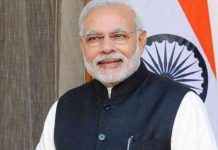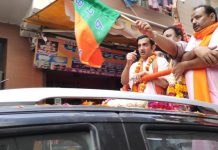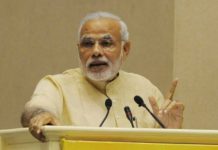YOGI ADITYANATH completed four years of power as chief minister of Uttar Pradesh on 19 March and celebrated its achievements put before the masses as report card of challenges turned into opportunities. Amid his preoccupied schedule, he found a little time to reply some of the questions posed to him by Tehelka’s MUDIT MATHUR

YOGI ADITYANATH, CHIEF MINISTER, UTTAR PRADESH
EDITED EXCERPTS FROM AN INTERVIEW •
Your government has completed four years, as Chief Minister. What is your biggest achievement?
After we came to power in 2017, we worked constantly and consistently towards the development of our state and its citizens and turned it into an ‘Economic Powerhouse. We had inherited the popular perception of an ailing state (‘Bimaru Pradesh’) about the state where nobody was ready to come in view of the collapsed law and order and development growth rate. Prior to 2017, farmers were in a miserable condition. The first thing we did after coming to power was waiving off farm debts worth 36,000 crore. Our government has constantly reinforced its commitment to prioritize farmers’ welfare and the growth of the agriculture sector by ensuring pro-farmer measures, including procurement of their crops. In the previous government, farmers suffered immensely.
What were the areas of farmers’ concerns?
Our priority was to make things right for the farmers. We developed a system to resolve the problems related to payments of cane dues that kept pending since 2010-11. Over 47 lakh sugarcane farmers in Uttar Pradesh have been paid a record cane price payment of more than 1,27,000 crore between 2017-2020. This cane price payment is also 31,785 crore more than the cane price payment of 95,215 crore paid during the five-year tenure of the previous government in 2012-2017.
BJP contested 2017 assembly polls on a slogan ‘Na Goonda Raj Na Bhrashtachar’. Have you been able to keep the promise?
Our government came heavily on crimes and criminals to the extent either they left the state or killed in encounters. They are as scared as they started feeling unsafe in UP jails. Safety of women has been our top priority ever since I have assumed office in 2017. We took appropriate steps to protect women from all kinds of crimes and ensured strict punishment to perpetrators so that potential criminals take a cue and mend their ways. Our approach and actions ensured that Uttar Pradesh led the way in controlling rape and other heinous crimes against women. The accused booked under The Protection of Children from Sexual Offences (POCSO) Act got harsh punishment. Speedy trials resulted in better conviction as eight accused sentenced to the death penalty and 193 accused imprisoned for life sentence while different punishment was given to 721 other accused.
What preventive measures you took for women safety?
We established women battalions of PAC in Lucknow, Badaun and Gorakhpur. A “Pink Bus Service” has been introduced for women passengers, in which we deployed security personnel and women conductors with CCTV cameras installed therein. We treated victims of ‘triple talaq’ with compassion and gave them all necessary government and police assistance to save them from domestic violence.
On the first day of the last Navratri festival, you launched ‘Mission Shakti’. What was your vision behind it?
The ‘Mission Shakti’ aimed to ensure safety and protecting dignity of women. Our two-fold endeavour has been to make it a public awareness campaign involving teachers, self-help groups, village chiefs and public at large with an objective to treat women with respect and dignity, providing them safety at all the places and simultaneously gearing up special policing efforts to check the rising crimes against women and help them become independent. We have appointed women nodal officers in all the districts for the execution and monitoring of the campaign.Such drastic measures witnessed a decline of 45.43 per cent in the rape cases, which is lowest as compared to the 21 major states of the country.
UP has distinct cultural identity since ancient times. How did you conserve it?
We did global branding of ‘Kumbh Mela’ in Prayagraj as a symbol of cultural nationalism and ancient center of Hindu pilgrimage based on the religious mythology. The 49 days long “Divya Kumbha, Bhavya Kumbha” event celebrated 15th ‘Pravasi Bhartiya Diwas’ to attract investments besides promoting our culture gave us global recognition. We spent 4,300 crore on Kumbh in 2019 for developing key infrastructure like electricity, water and sanitation facilities, public accommodation, convenience shops, food courts, vending zones, banks, ATMs, transport facilities and health centers established in the ‘Mela’ area.
What were major economic challenges before you and how did you overcome them?
Uttar Pradesh is the most-populous state in India as well as the most-populous country subdivision in the world. It covers 240,928 square kilometers equal to 7.34% of the total area of India, and is the fourth-largest Indian state by area. Despite its gigantic size, the state had only four airports till 2017 since its creation in 1950. Today in 2021, Uttar Pradesh has 18 airports and airstrips, the largest in the entire country.We have set the target of making Uttar Pradesh a one-trillion dollar economy. The Investors’ Summit brought global investment and infrastructure development to UP without creating a regional imbalance. Projects worth almost 3 lakh crore have been coming on ground out of intension of investment of 4.50 lakh crore we received from potential investors.
Our efforts yielded results as the per capita income of the state has almost doubled in the year 2020-21 as compared to per capita income of 2016-17. The per capita income has increased from 49,000 prior to 2017 to 95,000 in 2021. It is important marker for recording progress done by a state.
On ensuring the ease of doing business, the state recorded substantial jump in the State’s ranking in the recently announced Business Reform Action Plan ranking of states by DPIIT, Government of India. Uttar Pradesh bagged the second position — a jump of 12 positions in last three years. The state’s GSDP in the financial year 2020-2021 has crossed 19.48 lakh crore, equivalent to $268 billion, and UP has climbed to the second spot from number five in 2019-2020 in terms of size of GSDP in the country.
You come from backward region of eastern UP from where lot of people migrate to various parts of the country due to poverty and unemployment. How have you tackled the challenges?
We focused underdeveloped regions for infrastructure development projects such as the Purvanchal Expressway (340.82 km), Bundelkhand Expressway (296.070 km) and Ganga Expressway (596.00 km) that provided large scale employment to the people of the area who use to go to other state for want of work. Uttar Pradesh Defence Industrial Corridor (UP DIC) is another project that intends to reduce foreign dependency of Indian Aerospace and Defence Sector and boosting employment opportunities.
We also launched the ‘One District One Product’ initiative under MSME in 2018 which has revived traditional arts and handicrafts and aligns with Hon’ble PM Narendra Modiji’s clarion call of ‘Go Vocal For Local’ and ‘Atmanirbhar Bharat’. The implementation of ODOP has ensured 38.1% increase in the export from the state.
Reach of education to all was your government’s focus area. Are you satisfied with what was done on the ground?
We are quite satisfied with what has been done on the ground. Under our government’s ‘Operation Kayakalp’ initiative, elementary and primary schools have undergone total transformation in the state. So far 1.35 lakh government schools have been transformed. We are running 2.65 lakh schools to provide basic education in the state and in the academic year 2020-21, have facilitated admission of 1.85 crore children in schools to date under the ‘School Chalo Campaign.’
Besides, the government is providing books, school bags, shoes, socks and sweaters for boys and girls of council schools free of cost to ensure that no children be deprived of elementary education for want of money. As part of our commitment to providing quality education for children, the state government has appointed more than 1.20 lakh assistant teachers. The government is also running around 5,000 Smart Classes to provide technology-based education to the children in council schools.
The state government has also taken concrete steps to promote Sanskrit education in the state. The government is currently imparting Sanskrit education to 88.29 thousand students through 1,151 secondary Sanskrit schools in the state.
Besides, to avoid disruption of education and ensure continuation of educational activities in the state during the ongoing Covid-19 times, the government is running e-schools under its ‘Mission Prerna’ (inspiration) campaign where students are taught through digital and other modes of telecommunication.
We have also started the ‘Ábhyuday› initiative that aims to provide free assistance to all students who want to prepare for competitive exams like IAS, PCS but are unable to do so due to their weak financial situation. Almost 20 lakh students have registered themselves and more than 25,000 are attending classes physically.
Congress leaders Rahul Gandhi and Priyanka Gandhi have been most critical of the functioning of your government on law and order and handling of Covid-19. Your comments.
Rahul Gandhi and Priyanka Gandhi visit the state like guests. Their false propagandas will never be able to overshadow the work being done in the state for the upliftment of our citizens. The state has covered almost 19 crore people out of 24 crore population of the state under Covid-19 surveillance.
As for handling of Covid-19, the state was applauded by the global health institution — World Health Organisation (WHO) for successfully containing the pandemic despite the magnanimous size of the state. The state’s strategy was also praised by the ‘Economic Survey’.
Health and sanitation were major areas of worry for your government during lockdown and sudden crisis of migrant workers compounded the challenges. How did you manage this crisis?
Strengthening of health infrastructure in the state was our foremost agenda. The Covid-19 pandemic acted as a catalyst to upgrade of the state’s public health infrastructure rapidly. Prior to 2017, there were only 15 medical colleges in the entire state and the health facilities in the state were crumbling. Our government has laid the foundation of 30 medical colleges and now in 2021, studies in seven medical colleges out of 30 have begun. The 13 medical colleges have started its construction as many as eight colleges would come up next year. AIIMS are coming up in Gorakhpur and Rae Bareli as well. Six new super specialty medical blocks have been built.
It is the result of the improvement of health services and the activities under Swachh Bharat Abhiyan that the number of Japanese Encephalitis patients — an epidemic in children since the past four decades — has decreased by 56 per cent and the number of deaths has fallen by 90 per cent. We have successfully managed to contain Covid-19 as well and have strengthened our health infrastructure.
Unemployment remains the biggest issue concerning youth. Has your government launched a special scheme for that?
The current unemployment rate in Uttar Pradesh as of March 2021 stood at 4.1%, which is one of the lowest in the country as per the Centre for Monitoring Indian Economy (CMIE). Prior to 2017, unemployment was above 15% and after the reins of government came to us, the figures drastically came down to 2.1% in 2017 and till 2020 remained well below 10%. Uttar Pradesh has worked consistently and constantly to generate employment in the state and the result is quite evident with the figures now standing at 4.1%. The state last year launched ‘Mission Rozgar’ with the aim to provide employment to 50 lakh youths and we have already achieved the target. Also, 4 lakh youths have been employed in the government in the past 4 years.
Our aim based on “Swadeshi to Swavalamban” and way to achieve it has been “Vocal for Local” mantra. We designed One District-One Product (ODOP) scheme with our determination torevive traditional industries. Our targeted approach benefited millions of units of micro, small and medium enterprises (MSMEs) to secure loans on easy terms. This gave an impetus to the economy and paved the way for job creation. Under the ODOP scheme, units of cottage industries, supported by subsidy-based financial incentives and favourable environment, created more than four million jobs.
Under the “Ek Gram Panchayat Ek Banking Correspondent” scheme, 1.22 lakh ‘Banking Correspondent Sakhis’ have been employed so far. More than 25 lakh have been employed under the ‘One District One Product’ initiative of the government and 1.80 crore have been given employment under MSME sector.
The mega challenge that you highlighted during 2017 election campaign focused on political-criminal-bureaucratic nexuses at the highest level of governance swindling public money meant for the development of Uttar Pradesh. How you tackled these deep-rooted evils?
The state government has ‘Zero Tolerance’ towards crimes and criminals and there is no place for ‘Mafia culture’ in the state. Properties of criminals worth 834 crore were bulldozed and seized in 2020 and more worth 117 crore were confiscated this year under the Uttar Pradesh Gangsters and Anti-Social Activities Act. We will use the land from the 1,174 properties seized to build affordable homes and township projects for the poor.
PM Modi has often spoken of over population and UP is the most populous state of the country. Do you have any plans in mind to tackle it?
Hon’ble PM Modi ji said that those who follow the policy of small family also contribute to the development of the nation. It is also a form of patriotism. We will raise awareness about the benefits of keeping small families.
tehelkaletters@gmail.com












